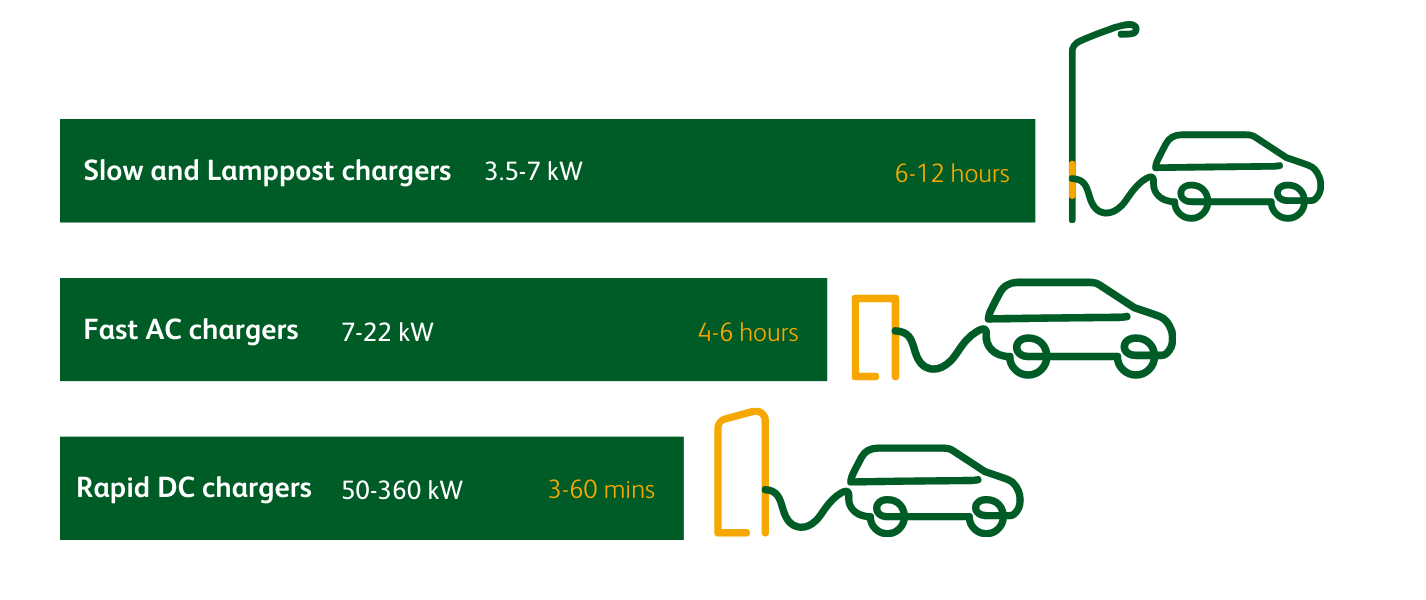Plug it in and off you go! A simple premise but there are a few questions that end users often have. What plug should you use? Can you charge at any charging station? We answer these questions and more in this article and show you that, often, the answer is quite simple.
How to find a charge point?
The battery of your electric vehicle (EV) is getting low, so you need to find a suitable charge point. Most drivers use an app (such as Zap-Map) to find their nearest charging point. In the app, you can see pricing, power and connector types at one glance. Many charge point operators (CPOs) also provide their own maps, for example, the interactive map on the ubitricity website so you can quickly find the nearest available charge points. This is particularly useful if you are a new EV driver or are traveling outside your local neighbourhood. Most regular EV drivers become quickly familiar with the charge points they use often around their homes, workplaces and other destinations.
Alternatively, you can use roaming apps such as Shell Recharge to find an EV charging point nearby. In addition to showing you available charge points near you, you can also use a variety of filters to make sure you only see relevant charge points for your vehicle (ie connector type, charging capacity, etc.).
What are the different types of charge points?
Slow charge points
Slow chargers are ideal for charging your car overnight or during an extended period of time as they optimise energy refuelling. Since it takes between 6 to 12 hours to fully charge an electric car, slow chargers are often found at home, or in lampposts in residential areas – like for instance, ubitricity lamppost charge points. Slow charging units are between 3.5 and 7 kW and most of them use a Type 2 connector – just like a wallbox at home. You need to have your own cable to use them, but EVs are sold with a cable when new. If you purchase a used EV, make sure to check with the dealership or the previous owner whether they are selling the car with a charging cable.
Fast charge points
Fast charge points charge a little more quickly, but don’t put too much pressure on the grid and, in the long run, on the car’s battery [source]. They also offer the advantage of compatibility since they also require a Type 2 plug to operate, which is the standard across the UK and Europe. The charging power of an AC charge point is usually between 7 and 22kW and will top up the charge of your car between 4 to 6 hours depending on the unit speed and the make of your vehicle. Like slow chargers, the charging occurs during the vehicle’s dwell time so that your EV is fully charged when you return to it next.
Rapid and ultra-rapid charge points
Rapid chargers are more common in urban areas as ultra-rapid charging points are more adapted to larger vehicles and fleets. These charge points charge on 50 to 360kW, which makes charging an EV considerably faster but puts more pressure on the grid and on your vehicle. The amount of kW that can be drawn depends on the make of the EV. There are two different plug types for DC charging: CCS and CHAdeMO. CCS is the standard in the UK and Europe, whilst CHAdeMO is being phased out in Europe and will only remain on Asian models [source].

How to connect a car to an ubitricity charge point?
With over 6,500 charge points installed in the UK, it’s very likely this will be your local charge point.
1. Park next to the charge point.
2. Connect your Type 2 charging cable into the charge point.
3. Plug the other end of the cable into your car, and the LED on the charge point will signal that it’s ready and waiting for authentication.
It’s that simple to charge your EV – in only 3 steps you’re ready to process payment and start charging your car.
How to activate charging and process payment?
Simplicity is key in enabling the expansion of e-mobility and the charging infrastructure. For ubitricity there are two different options for enabling payment: roaming or direct access.
Authentication can take place either via a smartphone app, for example from Shell Recharge. You can locate the nearest charge point with it and start the charge remotely through the app after plugging in your vehicle. Billing is handled by the charging card provider, in our example Shell Recharge.
The second option for using an ubitricity charge point is direct access. To use this method, you need to scan the QR code of the charge point with your smartphone and follow the instructions on the website. Charging starts once you have entered your payment details, either via bank card or Apple Pay/ Google Pay. Billing takes place directly via ubitricity, and you receive an email shortly after charging begins.
Charging on the go is easy
Whilst it is very different from filling up at the fuel pump, charging an EV is still very simple. As an EV driver, it’s important to be aware of the mix of charging infrastructure you can use depending on your needs. If you’re on the motorway, a rapid charger at a filling station or charging hub will be optimal to charge your car on-the-go, whilst you should prefer a slow or lamppost charger when parking your car overnight.
The ubitricity portfolio of charge points contributes to bringing intelligent solutions for charging electric vehicles. We transform streetlamps into public EV charge points, and we also offer individual solutions for rapid and fast charging in public urban areas.
Do you need more help with our lamppost charge points? Get in touch with our Customer Support team, available 24/7 on support@ubitricity.co.uk or call 0800 024 6279, and we’ll do our best to help you.

